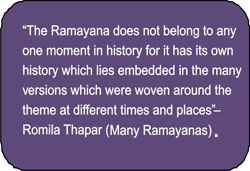| |
Initial Translations
 Ramayana passed into the multiple Indian languages only with the medieval period, when most of those languages were finding their feet. But there was a retelling of it in Prakrit in the 4th century AD – Paumachariya, the Jain version written by Bimal Suri. This also marks the first interlingual translation between Sanskrit and Prakrit. This was an anti-Brahminical text, where Ravana is not a monster or Hanuman a monkey, but “vidyadharas, semi-divine personages” (Dash and Pattanaik, 138). This also reveals how translations can be ‘original’ creations, marked by the ideology of the translator. Bhatti’s Bhattikavyam written in the 7th century AD was a retelling in Sanskrit itself. Ramayana passed into the multiple Indian languages only with the medieval period, when most of those languages were finding their feet. But there was a retelling of it in Prakrit in the 4th century AD – Paumachariya, the Jain version written by Bimal Suri. This also marks the first interlingual translation between Sanskrit and Prakrit. This was an anti-Brahminical text, where Ravana is not a monster or Hanuman a monkey, but “vidyadharas, semi-divine personages” (Dash and Pattanaik, 138). This also reveals how translations can be ‘original’ creations, marked by the ideology of the translator. Bhatti’s Bhattikavyam written in the 7th century AD was a retelling in Sanskrit itself.
The first of the Indian language versions was Kamban’s Iramavataram in Tamil, also known as Kambaramayanam. Dash and Pattanaik attribute this to Kamban’s anti-Sanskrit stance, as Tamil had a long history of independent existence behind it. Nagachandra in the 12th century wrote the Jain version of the Ramayana in Kannada, called Ramachandra Charitrapurana. This had a radically different story line, in that Ravana is the tragic hero of the epic. He abducts Sita in a moment of weakness and is killed by Lakshmana instead of Rama. Rama converts to Jainism in the end and becomes an ascetic. Nagachandra is known as Abhinava Pampa after the poet Pampa who wrote the Jain version of the Mahabharata. Sarala Das in his Oriya Bichitra Ramayana deviates slightly from Valmiki’s version. The washerman who tells tales which leads to the banishment of Sita is changed to a milkman who has an adulterous wife. When the wife is discovered by her husband, she is not defensive and asks her husband why he could not put up with her if Rama could tolerate a Sita who had stayed with Ravana. Dash and Pattanaik argue that this story challenges “the Brahminic notion of chastity and male domination” (147). Balaram Das’s Jagamohan Ramayana is also an Oriya text that subverts the well-known Valmiki version.
Other languages do not seem to have departed radically in terms of story and characterization like this. Krittivasa’s Bengali translation was in the 14th century. Ezhuthachchan’s Adhyatmaramayanam Kilippattu in the 15th century was modeled on the Sanskrit work Adhyatmaramayanam, and is believed to have laid the foundation of the Malayalam language. Tulsidas’s Ramcharitmanas in the 16th century was written in the Awadhi dialect of Hindi, and its aim was to infuse the spirit of bhakti in a people who were thought to be spiritually adrift. Tulsi who wrote during the Mughal period, is believed to have had the aim of drawing people to Hinduism through his retelling. His translation is thus a product of the socio-political context of his times, an individualist answer to what he felt to be the need of his age.
|